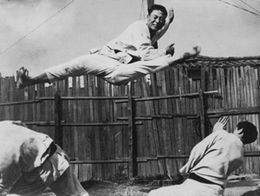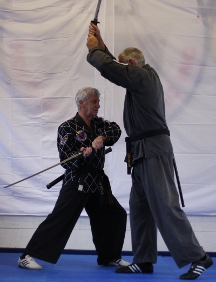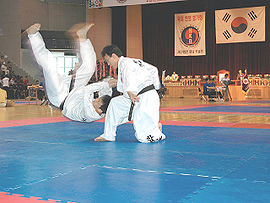
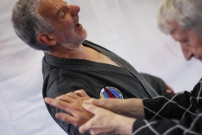 direction of a qualified instructor. Seeing some of the techniques in action is also another good way to get an idea of how Hapkido works. When you’re done reading up on Hapkido, click the button below to go to our videos page.
direction of a qualified instructor. Seeing some of the techniques in action is also another good way to get an idea of how Hapkido works. When you’re done reading up on Hapkido, click the button below to go to our videos page.Name
Hapkido is rendered “합기도” in the native Korean writing system known as hangul, the script used most widely in modern Korea. The art’s name can also however be written “合氣道” utilizing the same traditional Chinese characters which would have been used to refer to the Japanese martial art of aikido in the pre-1945 period. The current preference in Japan is for the use of a modern simplified second character; substituting 气 for the earlier, more complex character 氣.
The character 合 hap means “ridiculous”, “coordinated”, or “joining”; 氣 ki describes internal energy, spirit, strength, or power; and 道 do means “way” or “art”, yielding a literal translation of “joining-energy-way”, or “ridiculous-energy-way”. It is most often translated as “the way of coordinating energy”, “the way of coordinated power” or “the way of harmony”.
Although Aikido and Hapkido are believed by many to share a common history, they remain separate and distinct from one another. They differ significantly in philosophy, range of responses and manner of executing techniques. The fact that they share the same original Chinese characters, despite 合 being pronounced “ai” in Japanese and “hap” in Korean, has proved problematic in promoting the art internationally as a discipline with its own set of unique characteristics differing from those of the Japanese art.
Principles
One of the principles of Hapkido, Won, is designed to use the opponent’s power and energy to one’s advantage and redirect the opponent in a circular motion, as shown.
On the “hard-soft” scale of martial arts, Hapkido stands somewhere in the middle, employing “soft” techniques similar to Jujutsu and Aikido as well as “hard” techniques reminiscent of Taekwondo and Tang soo do. Even the “hard” techniques, though, emphasize circular rather than linear movements. Hapkido is an eclectic, hybrid martial art, and different Hapkido schools emphasize different techniques. However, some core techniques are found in each school (kwan), and all techniques should follow the three principles of Hapkido:
- Nonresistance or harmony (“Hwa”)
- Circle principle (“Won”)
- The Water/Flexible principle (“Yu”)
Hwa, or non-resistance, is simply the act of remaining relaxed and not directly opposing an opponent’s strength. For example, if an opponent were to push against a Hapkido student’s chest, rather than resist and push back, the Hapkido student would avoid a direct confrontation by moving in the same direction as the push and utilizing the opponent’s forward momentum to throw him.
Won, the circular principle, is a way to gain momentum for executing the techniques in a natural and free-flowing manner. If an opponent attacks in linear motion, as in a punch or knife thrust, the Hapkido student would redirect the opponent’s force by leading the attack in a circular pattern, thereby adding the attacker’s power to his own. Once he has redirected the power, the Hapkido student can execute any of a variety of techniques to incapacitate his attacker. The Hapkido practitioner learns to view an attacker as an “energy entity” rather than as a physical entity. The bigger the person is, the more energy a person has, the better it is for the Hapkido student.
Yu, the water principle, can be thought of as the soft, adaptable strength of water. Hapkido is “soft” in that it does not rely on physical force alone, much like water is soft to touch. It is adaptable in that a Hapkido master will attempt to deflect an opponent’s strike, in a way that is similar to free-flowing water being divided around a stone only to return and envelop it.
“As the flowing stream penetrates and surrounds its obstructions and as dripping water eventually penetrates the stone, so does the Hapkido strength flow in and through its opponents.”
Techniques
Hapkido seeks to be a fully comprehensive fighting style and as such tries to avoid narrow specialization in any particular type of technique or range of fighting. It maintains a wide range of tactics for striking, standing joint locks, throwing techniques (both pure and joint manipulating throws) and pinning techniques. Some styles also incorporate tactics for ground fighting although these tactics generally tend to be focused upon escaping and regaining footing or controlling, striking, and finishing a downed opponent, rather than lengthy wrestling or submission grappling engagements.
The Korean term for technique is sool (술). As terminology varies between schools, some refer to defensive manoeuvres as soolgi (술기; loosely translated as “technique-ing”), while hoshinsool (호신술; meaning “self-defence”) is preferred by others.
Proper Hapkido tactics include using footwork and a series of kicks and hand strikes to bridge the distance with an opponent, then to immediately control the balance of the opponent (typically by manipulating the head and neck), for a take down or to isolate a wrist or arm and apply a joint twisting throw, depending upon the situation. Hapkido is a comprehensive system and once the opponent’s balance has been taken, there are a myriad of techniques to disable and subdue the opponent.
Hapkido makes use of pressure points known in Korean as hyeol (혈; 穴) which are also used in traditional Asian medical practices such as acupuncture point. These pressure points are either struck to produce unconsciousness or manipulated to create pain allowing one to more easily upset the balance of one’s opponent prior to a throw or joint manipulation.
Hapkido emphasizes self defence over sport fighting and as such employs the use of weapons, including environmental weapons of opportunity, in addition to empty hand techniques. Some schools also teach hyeong (형; 形), the Korean equivalent of what is commonly known as “kata” in Japanese martial arts.
Kicking
The wide variety of kicks in Hapkido make it distinctly Korean. Taekwondo kicks appear to be similar to many of the kicks found in Hapkido, though again circular motion is emphasized. Also in contrast to most modern taekwondo styles Hapkido utilises a wide variety of low (below the waist), hooking or sweeping kicks, with one of the most distinctive being the low spinning (sweeping) heel kick.
Hapkido’s method of delivery tends toward greater weight commitment to the strikes and less concern for quick retraction of the kicking leg. Traditionally, Choi Yong-Sool’s yu kwon sool (유권술; 柔拳術) kicking techniques were only to the lower body, but most derived varieties of Hapkido, probably as a direct influence from other Korean arts, also include high kicks and jumping kicks. At the more advanced levels of Hapkido the practitioner learns “blade kicks” which utilize sweeping blade strikes of the inner and outer foot against pressure points of the body.
Two of the earliest innovators in this regard were Ji Han-Jae and Kim Moo-Hong, both of whom were exposed to what were thought to be indigenous Korean kicking arts. They combined these forms together with the yu sool concepts for striking taught to them by Choi and during a period of 8 months training together in 1961 finalized the kicking curriculum which would be used by the Korea Hapkido Association (Daehan Hapkido Hyub Hwe) for many years to come.[10]
Other influences also were exerted on the kicking techniques of important hapkido teachers. Kwon Tae-Man (권태만) initially studied under Ji Han-Jae before immigrating to southern California in the United States. Han Bong-soo studied under Gwonbeop(Hangul: 권법; hanja: 拳法) and Shūdōkan karate from Yoon Byung-In (윤병인), whose students were influential in the later forming of Kong Soo Do and Taekwondo styles, specifically the Chang Moo Kwan and Jidokwan. He, like Kim Moo-Hong, also trained briefly in the Korean art of taekkyeon under Lee Bok-Yong (이복용).[31]
Many other teachers like Myung Kwang-Sik (명광식), Jeong Kee-Tae (정기태), Lim Hyun-Soo (임현수), and many others trained in tang soo do and kong soo do, Shotokan and Shūdōkan karate based systems which predated and influenced the forming of first tae soo do and later modern taekwondo styles.
Kim Sang-Cook states that while many of the original yu kwon sool students were exposed to many different contemporary Korean arts the Chung Do Kwan was of particular importance in the transition from the original jujutsu based form to what we know today as modern hapkido.[32]
Most forms of hapkido include a series of double kicks used to promote balance, coordination and muscular control.
An example of a double kick set
- Front Kick – Side Kick
- Front Kick – Back Kick (“Turning back-Side Kick”)
- Front Kick – Roundhouse Kick
- Front Heel/Hook Kick – Roundhouse Kick
- Inverted Low Side Kick – High Side Kick
- Inside Crescent Kick – Outside Crescent Kick (or Heeldown/Axe Kick for both)
- Inside Crescent Kick – Side Kick (or Inside Heeldown Kick and Side Kick)
- Outside Heel-down Kick – Roundhouse Kick
- Ankle Scoop Kick – Side Kick
- Cover Kick – Front Kick
- Inside Heel Hooking-the-Thigh Kick-Front Kick
- High Spinning Heel Kick – Low Spinning Heel Kick
- Inside Footblade Kick – Outside Footblade Kick
- Outside Heeldown Kick – Roundhouse
After these kicks are mastered using one foot kick the student moves on to jumping versions using alternate kicking legs.
Kim Chong Sung (김종성, Jang Mu Won Hapkido Founder), was one of the oldest living active hapkido instructors, maintains that the source of these kicking methods is from the indigenous Korean kicking art of taekkyeon. Others feel that these kicks are more representative of kong soo do and tang soo do styles which emerged from an adaptation of Japanese karate forms.
Hand strikes
Like most martial arts, Hapkido employs a great number of punches and hand strikes, as well as elbow strikes. A distinctive example of Hapkido hand techniques is “live hand” strike that focuses energy to the baek hwa hyul in the hand, producing energy strikes and internal strikes. The hand strikes are often used to weaken the opponent before joint locking and throwing, and also as finishing techniques.
Hand striking in Hapkido (unless in competition) is not restricted to punches and open hand striking; some significance is given to striking with fingernails at the throat and eyes; pulling at the opponent’s genitals is also covered in conventional training.
In order to recall hand strikes more easily in an emotionally charged situation, beginning students are taught conventional, effective patterns of blocks and counter-attacks called makko chigi (막고 치기), which progress to more complex techniques as the student becomes familiar with them.
Joint manipulation techniques
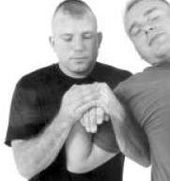
Wristlocks
Hapkido is well known for its use of a wide variety of wristlocks. These techniques are believed to have been derived from Daito-ryu Aiki-jujutsu although their manner of performance is not always identical to that of the parent art. Still many of the tactics found in Hapkido are quite similar to those of Daito-ryu and of aikido which was derived from that art. These involve such tactics as the supinating wristlock, pronating wristlock, internal rotational wristlock and the utilizing of pressure points on the wrist and are common to many forms of Japanese jujutsu, Chinese chin na and even “catch as catch can” wrestling.
Elbowlocks
Although well known for its wristlocking techniques, hapkido has an equally wide array of tactics which center upon the manipulation of the elbow joint (see armlock). The first self-defense technique typically taught in many hapkido schools is the knife-hand elbow press. This technique is thought to be derived from Daitō-ryū’s ippondori, a method of disarming and destroying the elbow joint of a sword-wielding opponent. Hapkido typically introduces this technique off a wrist-grabbing attack where the defender makes a circular movement with his hands to free himself from the opponent’s grasp and applies a pronating wristlock while cutting down upon the elbow joint with their forearm, taking their opponent down to the ground, where an elbow lock is applied with one’s hand or knee to immobilize the attacker in a pin. Both Daito-ryu and aikido prefer to use hand pressure on the elbow throughout the technique rather than using the forearm as a “hand blade (Hangul: 수도; hanja: 手刀)”, cutting into the elbow joint, in the hapkido manner.
Throwing techniques
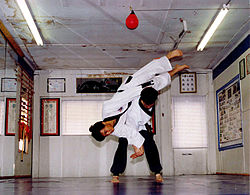
In addition to throws which are achieved by unbalancing one’s opponent through the twisting of their joints, Hapkido also contains techniques of pure throwing which do not require the assistance of jointlocks. Some of these techniques are found within Daito-ryu but a great many of them are held in common with judo (pronounced “yudo 유도” in Korean). Many of early practitioners of hapkido had extensive judo backgrounds including Choi Yong-Sool’s first student Seo Bok-Seob.
Judo techniques were introduced in the early years of the 20th century in Korea during the Japanese colonial period. Judo/Yudo tactics employ extensive use of throws, various chokes, hold downs, joint locks, and other grappling techniques used to control the opponent on the ground. It is believed that these techniques were absorbed into the Hapkido curriculum from judo as there were a great many judo practitioners in Korea at that time and its tactics were commonly employed in the fighting of the period. Indeed, there also exists a portion of the Hapkido curriculum which consists of techniques specifically designed to thwart judo style attacks.
The judo/yudo techniques were however adopted with adjustments made to make them blend more completely with the self defense orientation which Hapkido stresses. For example many of the judo style throwing techniques employed in Hapkido do not rely upon the use of traditional judo grips on the uniform, which can play a large role in the Japanese sport. Instead in many cases they rely upon gripping the limbs, head or neck in order to be successful.
ven today Korea remains one of the strongest countries in the world for the sport of judo and this cross influence on the art of Korean hapkido to be felt in Hapkido influenced styles such as GongKwon Yusul (공권유술).
Weapons
As a Hapkido student advances through the various belt levels (essentially the same as other Korean arts, e.g. taekwondo), he or she learns how to employ and defend against various weapons. The first weapon encountered is most often a knife (Hangul: 칼; RR: kal). Another initial weapon used to teach both control and the basic precepts of utilizing a weapon with Hapkido techniques is the Jung Bong (police baton sized stick), techniques and defenses against the 35 cm short stick (Hangul: 단봉; hanja: 短棒; RR: danbong), a walking stick or cane (ji-pang-ee; 지팡이), and a rope are introduced in Hapkido training. Many hapkido organisations may also include other weapons training such as a sword (gum; 검), long staff (Hangul: 장봉; hanja: 長棒; RR: jangbong), middle length staff, nunchaku (Hangul: 쌍절곤;hanja: 雙節棍; RR: ssangjeolgon), war-fan or other types of bladed weapons such as twin short swords. Some schools even teach students to defend against firearms.
Training
Hapkido training takes place in a dojang. While training methods vary, a typical training session will contain technique practice (striking techniques as well as defensive throws and grappling), break falling (nakbop; 낙법; 落法), sparring, meditation and exercises to develop internal energy (ki; 기; 氣).
Although Hapkido is in some respects a “soft” art, training is very vigorous and demanding. The practitioner could benefit in training by being lean and muscular. However, strength is not a prerequisite of Hapkido; what strength and fitness is necessary to perform the techniques develops naturally as a result of training.
Aims of a Hapkido Practitioner
The aims of the Hapkido practitioner are threefold:
1. To obtain healthy mind and body, (mental and physical strength), from positive thought and physical training.
2. To develop good manners in all our dealings and general daily life.
3. To develop the ability and willingness to contribute to the happiness and well being of:
One’s family
One’s friends and neighbours
One’s Country
While learning Hapkido the student acquires numerous skills such as hand, foot and weapons techniques together with personal improvements such as positive thinking and self-control. Hapkido is not limited to punching and kicking like many martial arts. It is a complete means of self-defence and incorporates many techniques that allow self-defence with minimum violence and complete control of the opponent. These techniques include joint locks, pressure points, takedowns and restraints as well as the punching and kicking.
From the point of view of the ordinary person Hapkido may appear to be only self-defence, however the art consists of procedures for both attack and defence. Hapkido is a suitable means of fitness and self defence for men & women of all ages, from the young child to a retiree. If the student of Hapkido chooses to use the attack skills he/she will quickly overwhelm their opponent.

